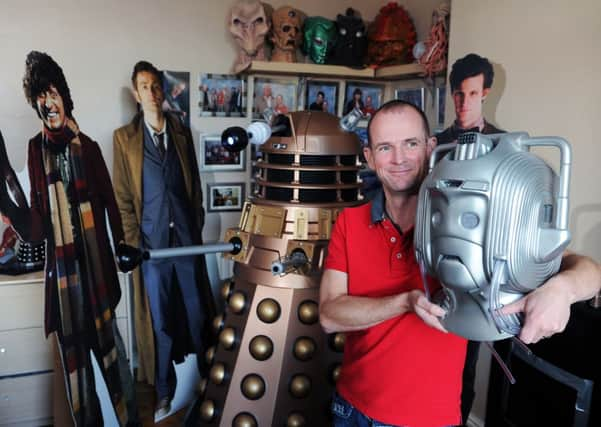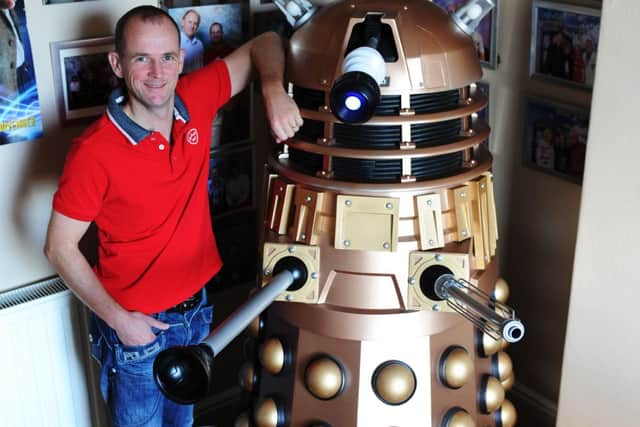Sci-Fi hero who has universal appeal


In recent weeks there’s been a flurry of activity on the various online forums dedicated to Doctor Who.
As the countdown to the special 50th anniversary episode got underway, the show’s most dedicated fans were barely able to contain their excitement...and their anxieties. Among the most fiercely debated threads were the merits or otherwise of reintroducing Paul McGann, who made a brief appearance as the Doctor back in 1996 and whether the 75-minute special will answer a billion and one questions about the Time War and the thorny issue of regeneration. One episode in the 1970s carelessly suggested the Doctor could only regenerate a dozen times. Back then no one thought the show would even survive the 80s, but with Peter Capaldi waiting in the wings to be crowned doctor number 12 it’s a plot detail the current writing team will have to side-step.
Advertisement
Hide AdAdvertisement
Hide AdBy 9.05pm this evening some of those dilemmas might have been resolved by a programme which has inspired successive generation of Whovians since the very first episode went out in black and white on November 23, 1963. It’s a peculiarly loyal following, the kind that slip lines from their favourite Time Lord into normal conversation and for whom the discovery last month of nine missing episodes from the 1960s in a Nigerian television station was cause for unbridled celebration.


“I realise that most people don’t care about reversing the polarity of a neutron,” says 40-year-old Dewsbury postman and superfan David Knill, referring to the catchphrase of the Third Doctor, John Pertwee. “And even I’ll admit that there are some fans who take it all a bit too seriously. They deconstruct every episode and quibble about the science, but I reckon if you’ve bought into the idea of a 900-year-old time traveller who goes about in a police box you probably shouldn’t be too picky.
“Doctor Who has always been part of my life; two of my earliest memories are of watching Jon Pertwee and then Tom Baker. It was what you talked about in the playground at school. Back when there were only three channels, television was much more of a collective experience. Even now if I put Genesis of the Daleks on it takes me right back to Saturday nights sat in front of the television eating potted meat sandwiches. I can honestly say it has enriched my life.”
It’s also cost him financially. Last week, David watched his cherished model of a Dalek being shipped off to the National Media Museum in Bradford which is staging an exhibition of Doctor Who memorabilia to mark the show’s half century. The tribute to the Doctor’s most famous nemesis came with a £1,500 price tag, but for David its value is more than simply monetary.
Advertisement
Hide AdAdvertisement
Hide Ad“Some Dalek models are little more than an upturned compost bin decorated with egg boxes, but this was a bit special and the friend who made it is now on with making me a K-9. I have had to rein it in a bit. It did get to the stage where I was buying things just to put them in a box in the attic, but now I tend to go for quality. I’ve just bought some limited edition coins for the 50th anniversary which cost £400, but I see that as more of an investment.”
The museum made a public plea for Doctor Who memorabilia and related memories in the summer and alongside offers of Tom Baker scarves and Tardis telephones, one man rang to tell curator Toni Booth how he had proposed at the Doctor Who exhibition in Blackpool while another confessed that when he finds himself with a difficult decision to make he often asks himself WWTDD? (What Would the Doctor Do?). Alongside the Dalek, David has also donated tankards which were made to mark the 30th anniversary along with Whovian-inspired Russian dolls which have reduced William Hartnell, the first Doctor, to no bigger than a thumbnail.
“In getting everything ready for the exhibition I’ve come across some things I haven’t seen for ages and sometimes it’s the small things which means the most. I remember as a child begging my mum and dad to take me to the exhibition on Blackpool’s Golden Mile and every so often I’ll come across a sticker or a pen they bought me from there. They’ve both passed away, so those kind of things bring back happy memories.
“I’d been thinking for a while that it would be lovely to share my collection with others, but it was my partner who encouraged me to get in touch with the museum. He tolerates my obsession and some friends have suggested that his enthusiasm for the exhibition is just a way of getting some of my stuff out of the house, but I like to think there’s no ulterior motive.”
Advertisement
Hide AdAdvertisement
Hide AdOne of those who has seen the Bradford exhibition take shape is fellow superfan Tim Neal, who works in the visitor insight department carrying out market research across the Science Museum Group. For the last few weeks he’s been keeping an eye on the exhibits as they’ve arrived and admits that even now when he walks past the Dalek his step quickens a little.
“They have a certain frisson to them, don’t they? In the 1980s a Doctor Who theatre show came to Leeds and I don’t think I’ll ever forget seeing the Daleks live on stage. They were so different to any other creature or baddie we’d ever seen before from the way they moved to the way they looked.”
Like David, Tim grew up with Doctor Who from the late 70s and while it was the television series which he fell in love with, it was the spin-off Target books which became his first real obsession.
“When I first became a fan there wasn’t an awful lot of merchandise to buy, which I guess is why I grabbed hold of the books. I remember my first encounter with the Target novels. It was in the local post office and I had to be dragged away by my mum, who didn’t think the content was suitable for a seven-year-old. I pleaded with her and that Christmas I got my first book.
Advertisement
Hide AdAdvertisement
Hide Ad“It was a revelation. The novels retold the television episodes and as well as being published to coincide with a new series they also revisited the stories of previous Doctors. You have to remember that this was an age before videos and until then I didn’t know about Patrick Troughton or William Hartnell. Scouring the shelves of WH Smith on a Saturday morning became a weekend ritual and I could spot the multi-coloured Target symbol on the spine from the other side of the shop.”
Later cassette tapes of unofficial audio recordings were passed around groups of Whovians and while some grew up and out of their obsession, Tim remained dedicated to the cause. So much so that he launched a website which he describes as a comprehensive guide to the Target novelisations. He’s not wrong.
“Doctor Who wasn’t just big in this country and I have tracked down all the foreign translations, well all except one. The collection is missing the the Brazilian edition of Doctor Who and the Day of the Daleks. I’ve only ever seen it on eBay once, but I was bidding against another buyer and when it got to £100 I decided to wave the white flag. He’s actually a friend of mine now, if only we’d have met sooner we could have probably come to a cheaper deal.”
It was May 1996 when it seemed the Doctor’s adventures had come to an end. The much criticised Sylvester McCoy bowed out and while the BBC insisted the show was just taking a break, few held out much hope of a revival.
Advertisement
Hide AdAdvertisement
Hide Ad“It’s funny really when the popularity of the TV show started to decline, fan activism actually stepped up and that’s when you first started to see the merchandise floodgates open with the first Doctor Who chess sets, board games and jigsaws,” says Tim. “I think because there were no new episodes, hardcore fans felt a responsibility to keep the show alive somehow.”
However, behind the scenes screenwriter and producer Russell T Davies was lobbying the BBC to revive the show. A fan himself, he was determined to bring the show into the 21st-century, extend the episode time from 25 to 50 minutes and cut down on the complex mythology.
Christopher Eccleston arrived on television screens in March 2005, a very different kind of Doctor to McCoy. With David Tennant and Matt Smith having sealed the show’s popularity, Doctor Who has once again become prime Saturday night viewing.
“Being a Doctor Who fan for a long time felt like following a non-league football club,” says Tim, who has not booked tickets to see the 50th anniversary episode The Day of the Doctor in 3D on the big screen, preferring the traditional huddle around a TV screen with a group of friends. “They were the wilderness years, It basically wasn’t very glamorous and people were almost embarrassed to admit they were a fan. The reboot has changed all that. Suddenly we can be normal.”
Doctor Who and Me: 50 Years of Doctor Who Fans, National Media Museum, Bradford, today to February 9. 0844 856 3797, www.nationalmediamuseum.org.uk.